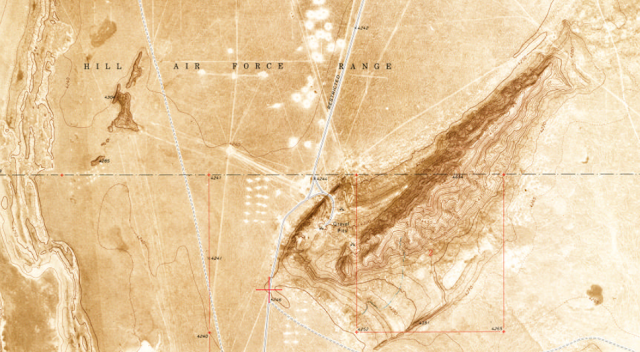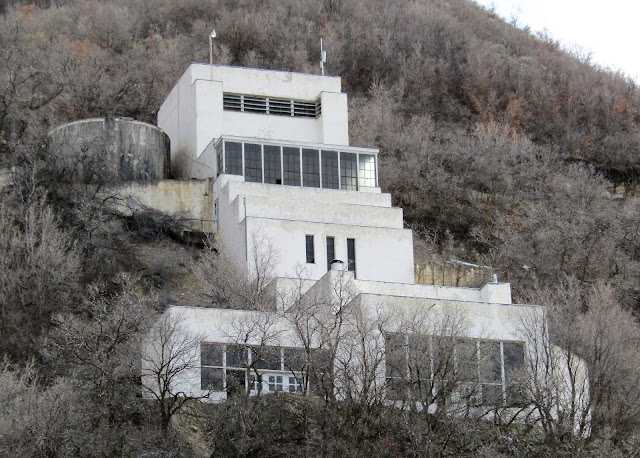McConkie Ranch Petroglyphs
by Peter
There are a few places in Utah where you can see really excellent examples of Native American rock art. You might have heard of Newspaper Rock, the Great Gallery in Canyonlands, Parowan Gap, and Nine Mile Canyon. McConkie Ranch is a bit less well-known, being a bit off the beaten tourist track, but is just as impressive in its own way. These well known sites are best to visit as they can handle visitors without damage, and are also the easiest way to see a lot of art in a small area.
To quickly define it, rock art is figures drawn, pecked, or scratched onto rock faces. It's generally divided into two categories. Petroglyphs are scratched, pecked, or carved into the rock face, often cutting through a dark surface patina to expose lighter rock beneath. Pictographs are painted. Most of the time when you hear about rock art, it was produced by Native Americans. However, it can also include later carvings and paintings on rocks. I've seen painted Union Pacific shields, names written in charcoal in caves, surveying marks, and the names of early settlers or explorers carved into the rock.
Rock art can be found throughout Utah, not just at the well-known, impressive locations. There is rock art along the Wasatch Front, in every national park, in canyons, in deserts, on cliffs, and on boulders.
There are a lot of possible theories about what rock art meant, but none of them are really provable. Some ideas include religious meaning (including as records of shamanistic visions and rituals), as sympathetic magic for hunting (you carve the animals you hope to meet in the hunt and are thus able to find them), as territory markers, to record events, as maps, as astronomical tools, or simply as ancient graffiti. The explanations of current Native groups should be given the most weight in this kind of subject, but they are also far enough removed in time and sometimes distance to make it difficult to interpret specific figures or panels.
Rock art is difficult to date. There are methods based on dating the sand beneath fallen panels (thermoluminescence) and the thickness of the patina coating that begins to reassert itself over time (possibly very location and condition specific, and therefore not reliable). Mostly, panels are dated by examining nearby sites (ideally right below the panel) and determining their dates of occupation and cultural affiliation.
In the Vernal area, including at McConkie Ranch, most of the rock art is associated with the Fremont culture. The Fremont were a widespread group of farmers, hunters and gatherers who ranged across most of Utah and portions of southwestern Wyoming, western Colorado, and eastern Nevada from around 2,000 years ago (0 AD) to around 700 years ago (1300 AD). They grew corn, made gray pottery, rabbit-fur robes and distinctive moccasins.
Also in Vernal, read about the Bank by Mail,
McConkie Ranch is privately owned and is made available to the public through donations. Currently they request a $5 donation per car. There are portable bathrooms at the parking lot. The visitor's center (a small hut to collect donations) also sells water and other drinks. There are two possible hikes, to the main petroglyphs to the east and north, and to the Three Kings panel to the south. We did the main hike. It's about a half mile out. You start going east up the slope to the base of the cliffs, then turn north and follow the cliffs. The most impressive panels start showing up after you've crossed a small box canyon, so don't turn around if you've already made it that far.
The trail is very rough, is steep at the beginning, and involves a bit of climbing over largish rocks. If you have mobility difficulties, this is not the hike for you. On the other hand, our three year old made it the entire distance (aside from one stretch of being carried because he tripped and kind of faceplanted in the sand) and enjoyed the climbing quite a lot.
The trail is marked with ribbons, ropes, and cairns, and signs are placed at strategic locations to tell you when to look further up the cliff. We had no trouble following the trail. McConkie Ranch is a little unique among petroglyph sites in that the figures are mostly not carved through a darker layer. This can make them a little hard to spot when you start out, but the signs help with that. Watch closely as you hike. This also made my photographs a little difficult because of the time of day (early afternoon). You'll get better visibility in the early morning or late afternoon.
Panels at McConkie Ranch include a lot of human figures (anthropomorphs), quite a few geometric figures, and a few animals (zoomorphs). Towards the north end of the trail, you'll see the great gallery, which includes a lot of human figures appearing to hold something that could be severed heads. Take a look and see if you agree.
Directions to McConkie Ranch: From Vernal, turn north on 500 West (State Highway 121), and follow the highway as it turns west on 500 North. Take a right (north) on 3500 West, signed for Dry Fork Canyon and the Red Cloud Interpretive Loop. Follow the road about 5.5 miles north to a turn-off on McConkie Ranch Road (signed for the petroglyphs). Follow the road around to the parking lot. Please respect the privacy of the residents in the area, and be appreciative for what they are making available for you to see.
There are a few places in Utah where you can see really excellent examples of Native American rock art. You might have heard of Newspaper Rock, the Great Gallery in Canyonlands, Parowan Gap, and Nine Mile Canyon. McConkie Ranch is a bit less well-known, being a bit off the beaten tourist track, but is just as impressive in its own way. These well known sites are best to visit as they can handle visitors without damage, and are also the easiest way to see a lot of art in a small area.
 |
| A rock art panel at McConkie Ranch. |
To quickly define it, rock art is figures drawn, pecked, or scratched onto rock faces. It's generally divided into two categories. Petroglyphs are scratched, pecked, or carved into the rock face, often cutting through a dark surface patina to expose lighter rock beneath. Pictographs are painted. Most of the time when you hear about rock art, it was produced by Native Americans. However, it can also include later carvings and paintings on rocks. I've seen painted Union Pacific shields, names written in charcoal in caves, surveying marks, and the names of early settlers or explorers carved into the rock.
Rock art can be found throughout Utah, not just at the well-known, impressive locations. There is rock art along the Wasatch Front, in every national park, in canyons, in deserts, on cliffs, and on boulders.
There are a lot of possible theories about what rock art meant, but none of them are really provable. Some ideas include religious meaning (including as records of shamanistic visions and rituals), as sympathetic magic for hunting (you carve the animals you hope to meet in the hunt and are thus able to find them), as territory markers, to record events, as maps, as astronomical tools, or simply as ancient graffiti. The explanations of current Native groups should be given the most weight in this kind of subject, but they are also far enough removed in time and sometimes distance to make it difficult to interpret specific figures or panels.
 |
| A spiral, a geometric design. Spirals are sometimes thought to represent the sun. |
Rock art is difficult to date. There are methods based on dating the sand beneath fallen panels (thermoluminescence) and the thickness of the patina coating that begins to reassert itself over time (possibly very location and condition specific, and therefore not reliable). Mostly, panels are dated by examining nearby sites (ideally right below the panel) and determining their dates of occupation and cultural affiliation.
In the Vernal area, including at McConkie Ranch, most of the rock art is associated with the Fremont culture. The Fremont were a widespread group of farmers, hunters and gatherers who ranged across most of Utah and portions of southwestern Wyoming, western Colorado, and eastern Nevada from around 2,000 years ago (0 AD) to around 700 years ago (1300 AD). They grew corn, made gray pottery, rabbit-fur robes and distinctive moccasins.
Also in Vernal, read about the Bank by Mail,
McConkie Ranch is privately owned and is made available to the public through donations. Currently they request a $5 donation per car. There are portable bathrooms at the parking lot. The visitor's center (a small hut to collect donations) also sells water and other drinks. There are two possible hikes, to the main petroglyphs to the east and north, and to the Three Kings panel to the south. We did the main hike. It's about a half mile out. You start going east up the slope to the base of the cliffs, then turn north and follow the cliffs. The most impressive panels start showing up after you've crossed a small box canyon, so don't turn around if you've already made it that far.
 |
| This is the rugged area of the hike. You can see a hiker crossing the box canyon in the lower left. |
The trail is very rough, is steep at the beginning, and involves a bit of climbing over largish rocks. If you have mobility difficulties, this is not the hike for you. On the other hand, our three year old made it the entire distance (aside from one stretch of being carried because he tripped and kind of faceplanted in the sand) and enjoyed the climbing quite a lot.
 |
| The view up from the beginning of the trail. Follow the ribbons. |
The trail is marked with ribbons, ropes, and cairns, and signs are placed at strategic locations to tell you when to look further up the cliff. We had no trouble following the trail. McConkie Ranch is a little unique among petroglyph sites in that the figures are mostly not carved through a darker layer. This can make them a little hard to spot when you start out, but the signs help with that. Watch closely as you hike. This also made my photographs a little difficult because of the time of day (early afternoon). You'll get better visibility in the early morning or late afternoon.
 |
| A zoomorph (an elk, maybe?). This panel also includes some pictographs, the painted figures at the right and bottom. |
Panels at McConkie Ranch include a lot of human figures (anthropomorphs), quite a few geometric figures, and a few animals (zoomorphs). Towards the north end of the trail, you'll see the great gallery, which includes a lot of human figures appearing to hold something that could be severed heads. Take a look and see if you agree.
 |
| A panel with a head? |


Comments
Post a Comment